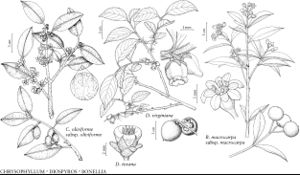Bonellia
Hortus Ripul., 21. 1824 ,.
Shrubs or trees, resin canals absent. Stems erect, much-branched; young branches puberulous, hairs relatively short, uniseriate [glabrous]. Leaves alternate or pseudoverticillate; blade elliptic to oblanceolate, base obtuse [attenuate], margins entire [serrate], apex obtuse to acute, aristate [mucronate or mucro absent], surfaces glabrous [pubescent], punctate. Inflorescences terminal racemes, 5–20-flowered, pedunculate. Pedicels present, bracteate. Flowers: sepals distinct; corolla yellow or orange [white or whitish], salverform or short-campanulate, lobes as long as or longer than tube, apex obtuse; stamens borne at base of corolla tube; filaments distinct; anthers at first aggregated around stigma and style, later spreading; staminodes borne at apex of corolla tube, petaloid; stigma capitate, lobed. Berries yellow [orange], ovoid or globose, apex apiculate. Seeds 1–8, dark brown, oblong or elliptic, flattened, slightly alveolate, partially covered by placental tissue.
Distribution
Fla., Mexico, West Indies (Greater Antilles), Central America, South America.
Discussion
Species 22 (1 in the flora).
